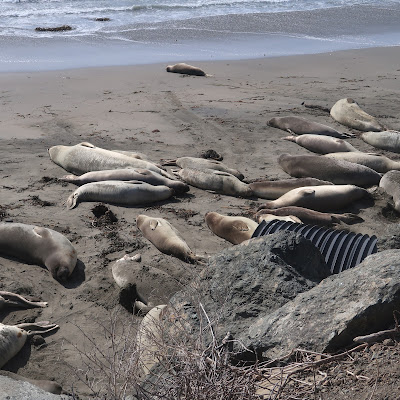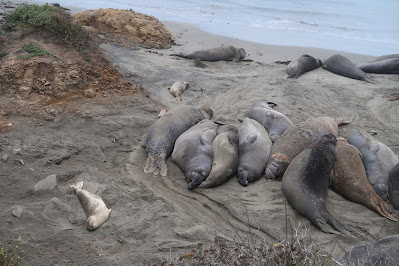Lots of activity during seal breeding season
The first pups of the season were born over the
December 16-17 weekend. More will follow, over 5,000 in the Piedras Blancas
rookery before the breeding season is over in mid-March.
Bulls fight for dominance, to reign over territory and
have breeding rights. Mothers protect their pups from the fray and high tides.
When it isn’t a noisy uproar, mothers nurse their pups peacefully, and sleep
beside them in scenes that evoke recognition of mothers everywhere.
Through the season, newborns start out skinny and fill
out to rotund 250-pound weaned pups. Bulls and mothers get thinner as time goes
by. Only the pups eat during the breeding season.
No schedule for births
Pups are born day and night. Everyone wants to witness
a birth, but predicting which seal will give birth next is uncertain. A
prospective mother may fuss and toss a lot of sand, digging ditches on both
sides of her round body. And then she may fall asleep.
While you’re watching one, another may give birth down
the beach. Gulls announce the births, swirling around to clean up the
afterbirth. Nature’s clean-up crew.
Pups may be born head or tail first. The water breaks,
and soon a pup emerges.
Recognize the new pup
Newborns have black coats. They are about three feet
long and weigh about 70 pounds. They soon plump up on their mothers’ nourishing
milk. They’ll nurse for a month. In the last few days of nursing, the mothers
mate with one or more males. They stop nursing the pup, who now weighs 250
pounds or more, and soon return to the ocean.
They need to feed, because they haven’t had anything
to eat since before they arrived at the beach. They lose about a third of their
body weight nursing that pup. It’s time to build up their blubber to support
development of next year’s pup.
After giving this year’s pup a head start, they go on their
annual short migration. They will return in two or three months, fatter, to
molt their skin.
Wildlife viewing requires patience. Pregnant females
will continue to arrive on the beach, into February. Check the live webcam for
beach conditions, www.elephantseal.org.
Bulls on alert
Dominant bulls, who rested peacefully next to their
brothers last summer, are now ready to take on all comers. Watch as one bull
surfs onto the sand. Bulls that scurry away are less dominant. The ones who
stand their ground are considering defending their turf.
The stand-off may come to blows. The goal of battling
is to establish the dominance hierarchy, which actually reduces conflict. Bulls
who acknowledge the dominant beachmaster won’t challenge him, and he won’t need
to fight every bull on the beach. But some will. A beachmaster can be deposed
by a tougher bull at any point during the breeding season.
Bulls have distinctive individual vocalizations. They
recognize each other. If they have fought before, they won’t challenge each
other again. They also recognize each other by sight.
But there’s always a new bull on the beach to raise
the issue. There’s a lot at stake. Only the most dominant bulls get to breed.
Bulls retreat to other beaches
Some less dominant bulls hang out on the beach,
evading the beachmaster’s notice and attempting to sneak in and mate.
Sometimes, they do!
Others leave the breeding beaches behind and swim to
other beaches to heal their battle wounds and rest. Visitors may encounter them,
especially at Hearst Memorial Beach at San Simeon Cove. Friends of the Elephant
Seal docents watch over seals and beachgoers, advising on how to avoid the seals
when they are resting on the sand or in the lagoon.
It’s an exciting and unusual experience, coming in
such close contact with huge wild animals. Bulls may challenge each other, or
simply ignore humans when they decide to move across the beach or return to the
ocean.
NOAA Marine Life Viewing Guidelines (https://sanctuaries.noaa.gov/wildlife-viewing/)
advise no closer than 50 yards, half a football field. Keep the dog leashed so
as not to annoy them. Don’t get between two seals, who may decide to charge
each other, or a seal and the water, in case he suddenly decides to go back
into the waves.
The seals can be dangerous, so give them plenty of
space. Sharing the beach with them is a privilege. And visitors get to return
home with a great story!
.JPG)


.JPG)
.JPG)
.JPG)

.JPG)









.JPG)



.JPG)





.JPG)
.JPG)

.JPG)
.JPG)
.JPG)
.JPG)